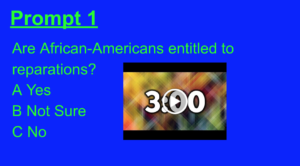In the midst of your last class discussion, you may have felt some pangs of disappointment. Perhaps, there was not enough engagement. Or maybe, the participation level was not satisfactory. Some students may have monopolized the airwaves. Well…I’m here to help.
In this episode, you’ll be treated to a step-by-step approach to epic class discussions. This template can be used repeatedly. Welcome, dear friends, to Philosophical Chairs Sturtevant-Style!
Step 1: Formulate a topic. This doesn’t necessarily have to be an ultra-engaging topic. Last week, my fourteen-year-old freshman dove headfirst into the issue of Indian Partition in 1947. You will not catch these kids tweeting about Nehru, but they sure were invested in debating about him. It was shocking how well it worked. That’s what the tactics I’ll outline can accomplish. You can make a pedestrian topic enthralling.
Step 2: Accumulate compelling sources. Here’s a link to the hyperdoc which set up my discussion on the slave trade. The primary sources come from the Stanford History Education Group. Please check out Episode 40 if you’d like to learn more about thee free resources. Embed provocative prompts inside the sources to get the kids thinking.
Step 3: Create a self evaluation sheet for students. Here’s mine. This sheet will add accountability. The students will demonstrate that they digested the prep material and be motivated to participate in the discussion.
Step 4: Compose 4 or 5 prompts. Students will have 3 choices with each question:
- A Yes
- B Unsure
- C No
The prompts will be unveiled to the kids and then they’ll be given 3 minutes to formulate responses. They should review the prep material and certainly conduct internet searches as well. Here is my slide presentation.
Step 5: Arrange the room so there’s 3 different sides. This is where the kids will go to demonstrate their feelings about the prompt. I have the A and C sides face one another and the Bs I place in the back facing you. Students should be encouraged to migrate freely during the discussion. It’s quite fine if they change their minds and it’ll give them an opportunity to contribute by explaining why they moved.
Step 6: Embrace the role of debate moderator. Draw kids out, call on reluctant students, ask students who move for an explanation, summarize a kid’s thoughts to help them express themselves, and occasionally, play devil’s advocate…but remember, your goal is to remain neutral.
Please try this Sturtevant-Style discussion. At the end of the class, there’ll be a number of hands frozen in the air…their disappointed owners sad that they couldn’t contribute just one more thought.
Listen to “95-Your Step-by-Step Guide to an Epic Class Discussion Sturtevant-Style” on Spreaker.
